[divider]Have you ever experienced a significant historic event and the person next to you experienced the same exact event very differently? Have you ever relived an experience you read about? Having different personal perspectives about the same historic event is often a universal experience. Years after her Father’s death, daughter/filmmaker Melinda Hess finally opens an unopened box after shipping it from location to location following her life and career for over twenty years. In that box is a suitcase. In that suitcase is stack of letters. All of the letters were written in 1946 from Fort Bliss, Texas to Washington Heights, NYC. Sitting on the floor of her studio Ms. Hess discovers one special letter – Letter# 31, with two unique qualities. It is the only letter from Cloudcroft, New Mexico, and it is unopened. What unfolds next is the filmmaker piecing together a braided story.
The Letters
[divider]The letters provide one narrative braid of the film. Private Sandy Hess’s voice is expressed through letter excerpts. One camera follows the careful inquiry into the untold period of time of the life, of a young, smart, Jewish engineer and solider.
The Travel Log
[divider] [h4]The Diary[/h4]Filmmaker Hess’s journey is captured as the ever moving daughter takes a parallel journey sixty-five years later trekking through her Father’s past activities.
[divider_top] [h2]Importance of Germany to the Story[/h2]Guided by her father’s letters, filmmaker Hess captures her first-person perspective framing her own emotional response to what she sees, what she projects and the reflection she receives back from this journey.
Traveling to Germany, to the sites where the V2s that formed the basis of the U.S. Space program were build and launched, to see and witness first hand the effects of the Holocaust on German and Jewish lives delivers a narrative crescendo of the film. Meeting with Germans of different generations, listening to their stories of remembrance, the filmmaker seeks to liberate herself from emotional shackles, offering insight into personal transformation and approaching some kind of understanding of how the personal pieces of her Father’s story fit into this historic moment in history.

Von Braun House at White Sands Missile Range
 [/caption]
[divider]
[h5]Rocket Scientists Contribute Much to America[/h5]
[/caption]
[divider]
[h5]Rocket Scientists Contribute Much to America[/h5]
[divider_top] [h2]Film’s Aim[/h2] [dropcap_2]• [/dropcap_2][highlight_dark] LETTER FROM CLOUDCROFT examines issues of transformation and potential understanding for individuals and nations.…but at what cost? How does one gauge the guilt or criminality of an enemy when he is ‘working’ for a dictatorship? What is his complicity and responsibility? Were the rocket scientists guilty of war crimes by participating in the machinery of the Nazi regime?
[/highlight_dark] [blockquote]One underlying theme in LETTER FROM CLOUDCROFT is the effort to juxtapose conflicting realities – WWII and it’s aftermath with the United States Space Program, as the filmmaker combines perceptions of her Father, with her country’s potential ethical incongruities and post-war actions. How does an individual or a nation confront traumas and expose retold myths? It is the aim of this film to serves as a platform for authentic dialectic stories to be told, with personal narratives serving as catalysts for change. Today, travel to space that began with Wernher von Braun’s inspired rocket launches to the moon are no longer the domain of NASA, but instead in the realm of private and commercial enterprises. Sixty Five years after the letters in this film were written, in the nascence of the U.S. missile and space programs, NASA is going through enormous changes in its mission and identity as is the United States of America. [/blockquote] [divider_top]
